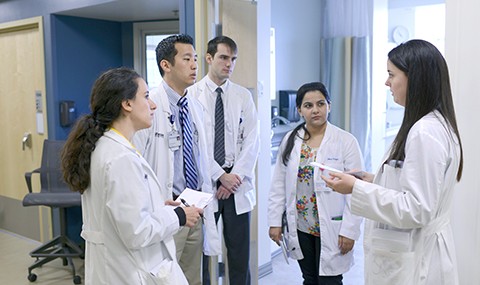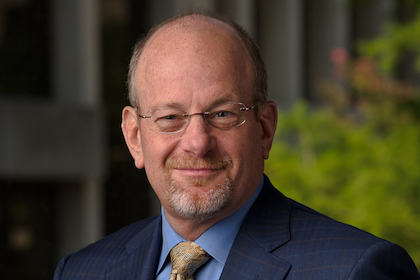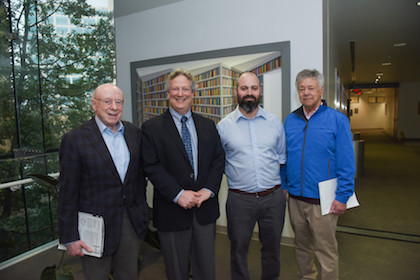Medical education goes 'new school' with curriculum
By Cathy Frisinger
The new realities of medicine demand a different kind of medical education, and UT Southwestern Medical School will debut a revised curriculum in the fall of 2015 designed to better train students to be knowledgeable, confident, and forward-looking physicians and scientists.

In June 2013, under the leadership of Dr. J. Gregory Fitz, Executive Vice President for Academic Affairs and Provost, and Dean of UT Southwestern Medical School, the work of overhauling the medical school curriculum began. A committee of five academic leaders was formed, led by Dr. James Stull, Chairman of Physiology, and Chair of the group, and Dr. Dennis Burns, Professor of Pathology and Co-Chair of the committee.
Each week the committee met to outline how an already outstanding medical school curriculum could be modified and enhanced. As these plans developed over 150 faculty were engaged in development of a final curriculum plan for the pre-clerkship period with input from current medical students. The planning process was a community effort with no curriculum “czars.”
“We have taken the first two years and mixed it up,” said Dr. Stull of the new curriculum. “Instead of being disciplines in silos, we’re integrating. We’re using current content but pulling it together in new and better ways.”
Rather than attending courses titled Anatomy and Immunology, students beginning their medical education in August 2015 will attend a block called Body Structure Functions, which incorporates gross anatomy, embryology, histology, and radiographic imaging, and a Foundations of Biomedical Sciences block, which incorporates biochemistry, genetics, cell biology, physiology, neuroscience, microbiology, immunology, and pathology.
“One of the challenges that you have when you are teaching a first-year normal and a second-year abnormal is that you spend a lot of time reviewing. What we are aiming for is eliminating redundancy,” said Dr. Burns.
Under the new curriculum, students will be ready to dive into the core clerkships in January of their second year – half a year earlier than under the old curriculum – which will please students.
“Everyone is really eager to see patients, to treat them, to help them,” said Sam Parnell, a third-year medical student. “At the end of the day, we’re all here to serve patients, and when you’re able to see the start of that, that’s what gets you going, gets you excited.”
The core clerkships that incoming medical students will take are the same – internal medicine, surgery, pediatrics, etc. – but the clerkships will be spread out over 72 weeks rather than 48 weeks, giving students the opportunity to intersperse other activities, such as laboratory or clinical research, electives, and sub-internships.
In the post-clerkship period, among other classes, students will take a Back-to-Basics block that will return their focus to basic science subjects,
such as biochemistry and cell biology, but at a more sophisticated level that will be integrated with their newly acquired clinical knowledge. For example, a student anticipating becoming an obstetrician could select a Back-to-Basics block that focuses on reproductive biology at the cellular level.
The new curriculum also will train students to think of themselves as part of a team, foster relationships between students and experienced clinician mentors, and teach students how to identify the relevant information from among a mountain of facts and synthesize that information into problem-solving for patients.
The curriculum will employ more small-group and team-based learning in which students can engage in fluid discussions with professors, and include more active learning (simulations and clinical scenarios) and less passive learning (lectures). Furthermore, it will guide students to become self-learners so they can continue to expand their knowledge throughout their careers and keep up with the explosion of scientific advances and new technologies.
“Medical education is evolving away from memorization and toward developing critical-thinking skills,” Dr. Stull said. “Students don’t need to memorize drug dosages; they can pull them up on their mobile phones.”
At least one thing will stay the same, under the new curriculum. “We are a science-oriented school, and we are going to remain a science-oriented school,” Dr. Stull emphasized.
A learning block titled Foundations of Clinical Reasoning is a new addition that will introduce first-year students to principles of epidemiology, biostatistics, and evidence-based medicine. “We have taught some of these topics in a catch-as-catch-can manner. This will shift to formal, didactic presentations on these topics,” Dr. Burns said.
One of the key changes to the curriculum is the addition of a 12-week scholarly project that every student will be required to complete.
“We have had thoughtful and creative input from every party on designing the new curriculum – students, clinicians, investigators, and teachers,” said Dr. Fitz. “Dr. Stull and Dr. Burns, and their committee members, have done an outstanding job in synthesizing these ideas to create an exciting model.”



